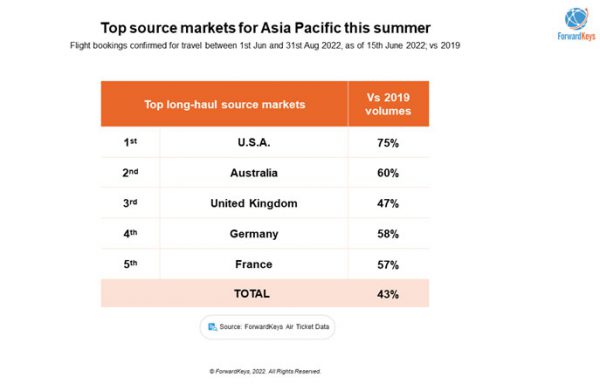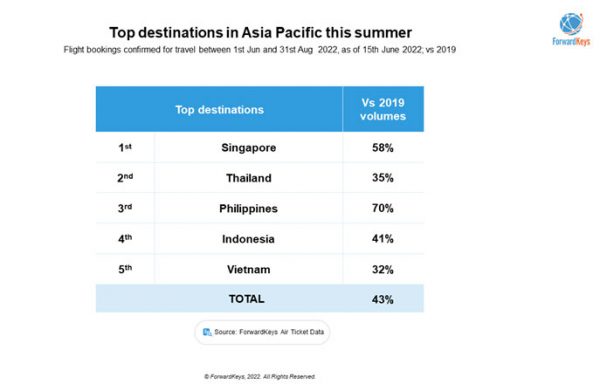SINGAPORE, 20 June 2022: Southeast Asia lags far behind the rest of the world in recovering from the Covid-19 pandemic according to the latest data from ForwardKeys that suggested visitors from the USA returned in greater numbers than from other origin markets.
In the first five months of the year (January to May), travel to Southeast Asia reached just 18% of pre-pandemic levels, whereas travel to Europe reached 55%, to the Americas 66% and the Middle East & Africa 64%.

Looking ahead to the summer months (June to August), flight bookings for Southeast Asia are at just 43% of pre-pandemic levels, whereas bookings for Europe are at 70%, for the Americas are at 78% and for the Middle East & Africa are at 85%
This summer’s analysis of long-haul flight bookings reveals that travel from the USA is set to reach 75% of where it was in 2019, before the COVID-19 outbreak. Australia is the next healthiest source market in which bookings are far behind, at 60% of 2019 levels. It is followed by the UK, at 47%, Germany, at 58%, and France, at 57%.
The most popular destinations for US visitors are the Philippines, Singapore, and Indonesia. Helpfully, as US tourists are known for high spending, average trip durations appear to be significantly longer than before the pandemic. This visitor profile is also more affluent, with 17% flying in the front of the plane, compared to 9% in the equivalent months in 2019.
The destinations which are recovering most strongly are the Philippines and Singapore. Summer flight bookings for the Philippines are currently at 70% of pre-pandemic levels, for Singapore, 58%, for Thailand, 35%, Indonesia at 41% and Vietnam, 32%. Travel to the Philippines is dominated by people returning to visit friends and relatives, whereas travel to other destinations is more for work and leisure.
Throughout the pandemic, airlines flying to Southeast Asia have provided enough seat capacity to accommodate passenger demand. However, in May 2022, the acceleration in demand started to outstrip capacity, which has been creating upward pressure on airfares.
Government-imposed travel restrictions provide the best explanation of the observed recovery trends, as the destinations that relaxed restrictions earlier, such as the Philippines and Singapore, have recovered more strongly.
Some of the most significant dates and changes to travel regulations include:
10 February Philippines – opens to vaccinated travellers without quarantine, but a pre-departure test is required
27 March India – opens to all travellers without quarantine
1 April Singapore – opens to vaccinated travellers without quarantine and tests
18 April Australia – opens to vaccinated passengers without quarantine, but a pre-departure test is required
1 May Malaysia – opens to vaccinated travellers without quarantine and tests
1 May Thailand – opens to vaccinated travellers without quarantine and tests, but pre-travel registration, with details of vaccination and insurance, is needed
15 May Vietnam – opens to all travellers with no Covid-related entry rules
18 May Cambodia – opens to vaccinated travellers without quarantine and tests
18 May Indonesia – opens to vaccinated travellers without quarantine and tests
8 June South Korea – opens to vaccinated travellers without quarantine, but a pre-departure test is required
10 June Japan – opens to tourists in tour groups from 98 countries
31 July New Zealand – will reopen two months earlier than originally planned
ForwardKeys VP Insights Olivier Ponti commented: “Travel during the pandemic has been a function of pent-up demand pushing in one direction and pandemic protection rules pushing back in the opposite direction. The recovery of air travel in Southeast Asia is lagging because travel restrictions there have been tougher. China, which used to be Southeast Asia’s largest source market, is still closed. Japan, another major travel market, is reopening very cautiously, and seat capacity, which is constrained, is leading to higher airfares, which in turn dampens demand.”

(Source: ForwardKeys).




